Id4, a New Candidate Gene for Senile Osteoporosis, Acts as a Molecular Switch Promoting Osteoblast Differentiation
Excessive accumulation of bone marrow adipocytes observed in senile osteoporosis or age-related osteopenia is caused by the unbalanced differentiation of MSCs into bone marrow adipocytes or osteoblasts. Several transcription factors are known to regulate the balance between adipocyte and osteoblast differentiation. However, the molecular mechanisms that regulate the balance between adipocyte and osteoblast differentiation in the bone marrow have yet to be elucidated. To identify candidate genes associated with senile osteoporosis, we performed genome-wide expression analyses of differentiating osteoblasts and adipocytes. Among transcription factors that were enriched in the early phase of differentiation, Id4 was identified as a key molecule affecting the differentiation of both cell types. Experiments using bone marrow-derived stromal cell line ST2 and Id4-deficient mice showed that lack of Id4 drastically reduces osteoblast differentiation and drives differentiation toward adipocytes. On the other hand knockdown of Id4 in adipogenic-induced ST2 cells increased the expression of Pparγ2, a master regulator of adipocyte differentiation. Similar results were observed in bone marrow cells of femur and tibia of Id4-deficient mice. However the effect of Id4 on Pparγ2 and adipocyte differentiation is unlikely to be of direct nature. The mechanism of Id4 promoting osteoblast differentiation is associated with the Id4-mediated release of Hes1 from Hes1-Hey2 complexes. Hes1 increases the stability and transcriptional activity of Runx2, a key molecule of osteoblast differentiation, which results in an enhanced osteoblast-specific gene expression. The new role of Id4 in promoting osteoblast differentiation renders it a target for preventing the onset of senile osteoporosis.
Published in the journal:
. PLoS Genet 6(7): e32767. doi:10.1371/journal.pgen.1001019
Category:
Research Article
doi:
https://doi.org/10.1371/journal.pgen.1001019
Summary
Excessive accumulation of bone marrow adipocytes observed in senile osteoporosis or age-related osteopenia is caused by the unbalanced differentiation of MSCs into bone marrow adipocytes or osteoblasts. Several transcription factors are known to regulate the balance between adipocyte and osteoblast differentiation. However, the molecular mechanisms that regulate the balance between adipocyte and osteoblast differentiation in the bone marrow have yet to be elucidated. To identify candidate genes associated with senile osteoporosis, we performed genome-wide expression analyses of differentiating osteoblasts and adipocytes. Among transcription factors that were enriched in the early phase of differentiation, Id4 was identified as a key molecule affecting the differentiation of both cell types. Experiments using bone marrow-derived stromal cell line ST2 and Id4-deficient mice showed that lack of Id4 drastically reduces osteoblast differentiation and drives differentiation toward adipocytes. On the other hand knockdown of Id4 in adipogenic-induced ST2 cells increased the expression of Pparγ2, a master regulator of adipocyte differentiation. Similar results were observed in bone marrow cells of femur and tibia of Id4-deficient mice. However the effect of Id4 on Pparγ2 and adipocyte differentiation is unlikely to be of direct nature. The mechanism of Id4 promoting osteoblast differentiation is associated with the Id4-mediated release of Hes1 from Hes1-Hey2 complexes. Hes1 increases the stability and transcriptional activity of Runx2, a key molecule of osteoblast differentiation, which results in an enhanced osteoblast-specific gene expression. The new role of Id4 in promoting osteoblast differentiation renders it a target for preventing the onset of senile osteoporosis.
Introduction
Senile osteoporosis or age-related osteopenia is accompanied by increased bone marrow tissue adiposity [1]. Bone marrow adipocytes and osteoblasts are thought to originate from common mesenchymal stem cells (MSCs). Therefore, it has been suggested that the excessive accumulation of marrow adipocytes following bone loss is caused by unbalanced differentiation of MSCs into marrow adipocytes and osteoblasts [2]. Support for this hypothesis comes from studies of peroxisome proliferators-activated receptor-γ (Pparγ), a master regulator of adipocyte differentiation, deficient embryonic stem cells that showed an increase in osteoblast differentiation [3]. In contrast, calvarial adipocyte differentiation is augmented when runt-related transcription factor 2 (Runx2), a master regulator of osteoblast differentiation has been knocked out [4]. Transcription factors Runx2 and Sp7 transcription factor 7 (Sp7) regulate MSC commitment to osteoblast differentiation along with bone morphogenetic protein (BMP) signaling pathway [5]. Conversely, Pparγ and CCAAT/enhancer binding protein (C/EBP) transcription factor family members drive MSCs differentiation toward adipocytes [6]. Other proteins that regulate the balance between adipocyte and osteoblast differentiation are tafazzin, Wnt5a, Wnt10b, Msx2, C/EBPβ and basic helix-loop-helix (bHLH) family member e40 (Bhlhe40) [6]–[8]. Aforementioned transcription factors suppress adipocyte differentiation and promote osteoblast differentiation. Regardless of these studies, the precise molecular mechanisms that regulate the balance between osteoblast and adipocyte differentiation in the bone marrow has yet to be elucidated. Hence, we aimed to identify transcription factors that regulate the direction of differentiation toward osteoblast or adipocyte by analyzing their genome-wide expression profiles in differentiation time series experiments.
We noticed in early phases a subgroup of transcription factors that appeared to function in both osteoblasts and adipocytes differentiation. Particularly, bHLH superfamily transcription factors were significantly enriched and up-regulated in the early phase of osteoblast differentiation.
The bHLH superfamily comprises transcription factors that form homo- or heterodimers and typically bind to a consensus sequence (CANNTG) called an E-box [9]. It is well known that bHLH transcription factors play important roles in development and cell differentiation. For example, Myod1 is a key differentiation factor of myoblasts and Srebf1 is involved in adipocyte differentiation [10], [11]. Hairy and enhancer of split (Hes) family members of bHLH superfamily are crucial regulators of cortical development [12].
Here, we have identified Inhibitor of DNA binding 4 (Id4), which also belongs to the bHLH superfamily as a key molecule that regulates the direction of differentiation toward osteoblast or adipocyte in vitro and in vivo using genome wide expression study. Furthermore, we established that Id4 promotes osteoblast differentiation by enhancing Runx2 transcriptional activity through stabilization of Runx2 protein. The new role of Id4 in directing osteogenic and adipogenic cell fate makes it a likely target for preventing the onset of senile osteoporosis.
Results
Genome-wide expression profile predicts Id4 as a candidate molecular switch in osteoblast and adipocyte differentiation
To delineate the sequential changes of transcription factors activating and repressing downstream osteogenic and/or adipogenic target genes, we evaluated the differentiation capability toward both osteoblasts and adipocytes using six cell lines (ST2, C2C12, DFAT-D1, PA6, 10T1/2, NRG). Of these, bone marrow-derived stromal cell line ST2 differentiated most efficiently into both osteoblasts and adipocytes (data not shown). Using Affymetrix mouse GeneChip, we aimed to identify clusters of transcription factors that are temporally co-regulated in one but not in another cluster (CIBEX Accession number: CBX90). Of 1,270 transcription factors, 407 genes were significantly up- or down- regulated in either osteoblast or adipocyte differentiation compared to the non-induced control (Table 1 and Table S1). Hierarchical clustering analysis of transcription factor gene expression data at 15 osteoblast and seven adipocyte differentiation time points (Figure 1A) revealed distinct clusters that represent phases of sequentially expressed transcription factors (Figure 1B). Differentiation into osteoblasts is characterized by five phases (Figure S1) whereas adipocyte differentiation resulted in four phases (Table S1). The early phases of osteoblast (1 hr) and adipocyte (48 hr) differentiation showed the greatest variability in transcription factor expression levels (Figure 2A and Table S1).
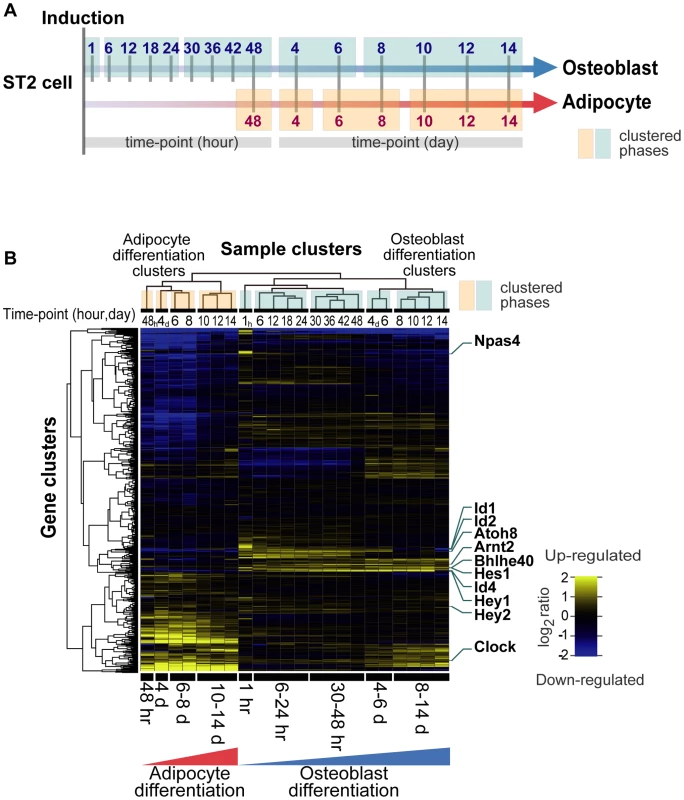
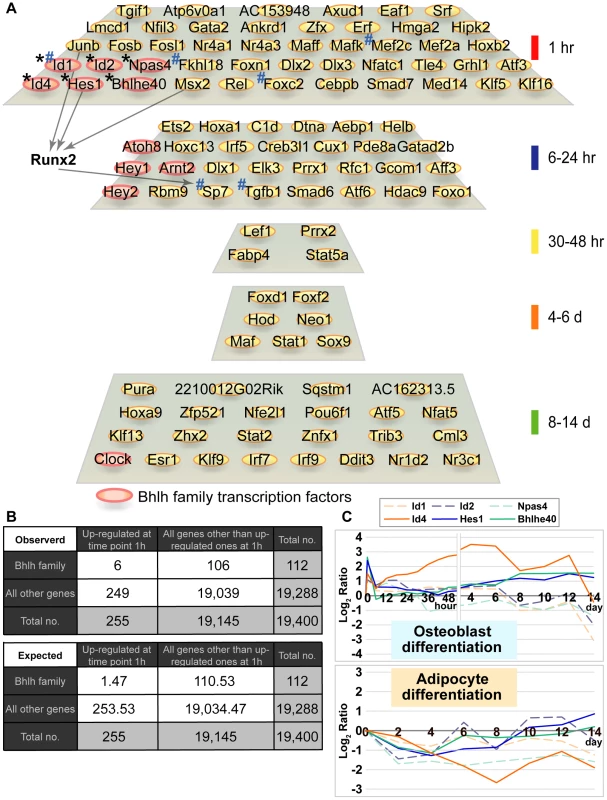
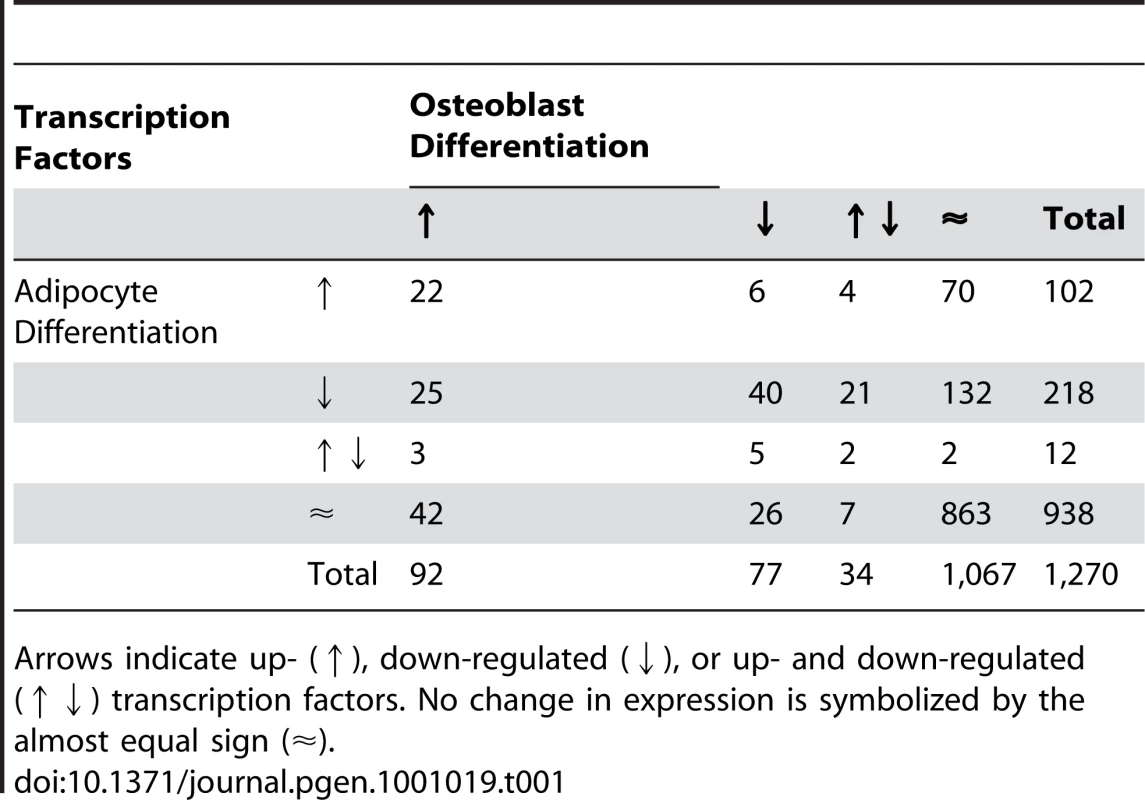
Chi-square testing for over-representation of transcription factors in each differentiation phase supported only six up-regulated bHLH superfamily members (Id1, Id2, Npas4, Id4, Hes1 and Bhlhe40) of the immediate early phase osteoblast differentiation (1 hr) as significantly (p<0.01) enriched (Figure 2B). Since Id4, Hes1 and Bhlhe40 expression increased (decreased) twofold or greater during osteoblast (adipocyte) differentiation compared to the control (Figure 2C and Table 2), these transcription factors are likely to play a pivotal role in the regulation of osteoblast and adipocyte differentiation.
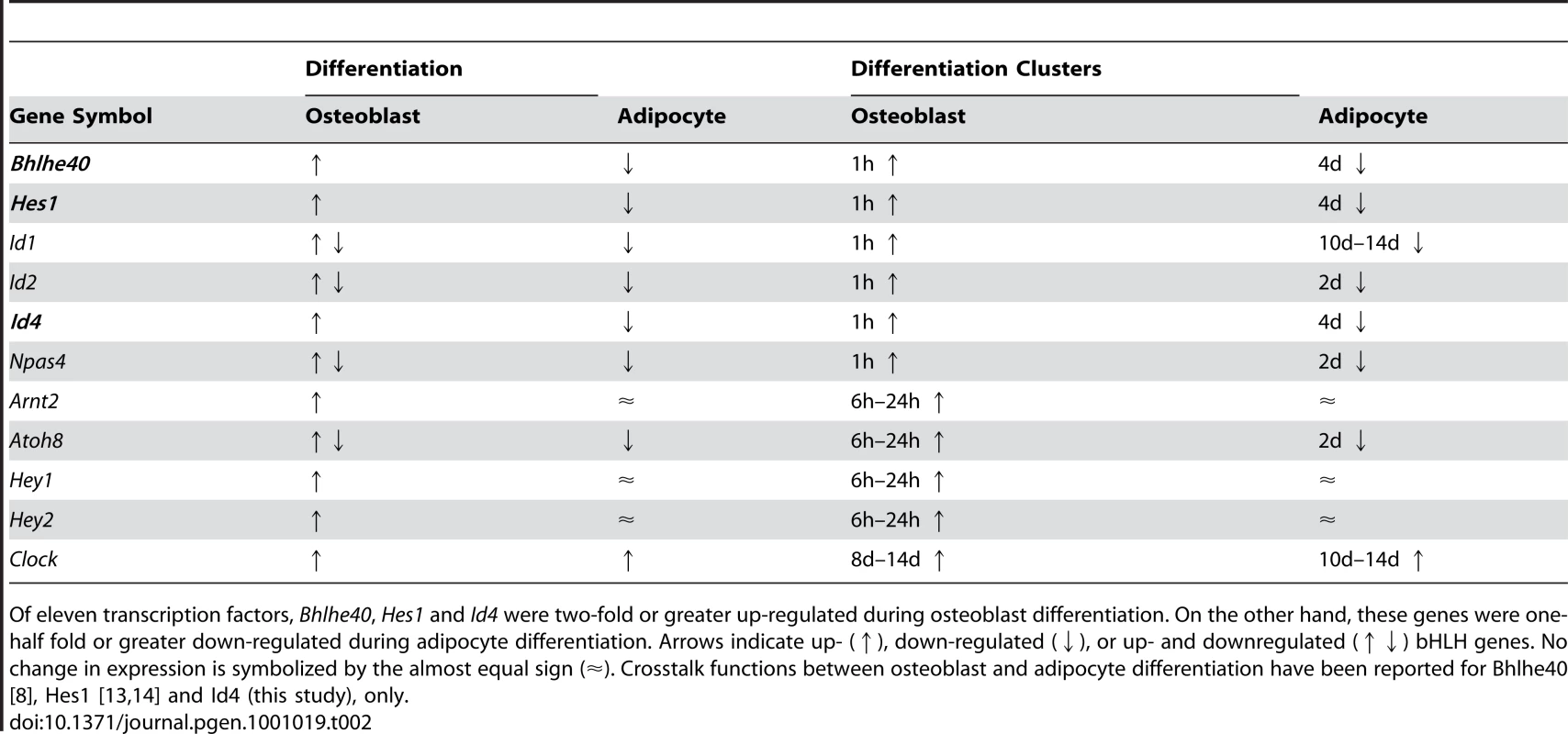
Indeed, Hes1 and Bhlhe40 are known to be involved in both differentiation pathways [8], [13], [14], whereas Id4 has not yet been implicated in either differentiation pathways. Additionally, Id4 expression patterns in osteoblast and adipocyte differentiation were also compared by quantitative real-time PCR (qRT-PCR). Expression of Id4 significantly increased during osteoblast differentiation, attained a peak on day 4 and decreased thereafter (Figure S2A). In contrast, Id4 expression decreased during adipocyte differentiation (Figure S2B). Expression levels of Id1 and Id2 were also up-regulated in the early stage (1 hr) of osteoblast differentiation, but thereafter their expression dropped to base levels (Figure 2C, upper panel). Therefore, we hypothesized that Id4 may act as a novel molecular switch in osteoblast and adipocyte differentiation.
Aside from Id4, Hes1 and Bhlhe40, we identified additional bHLH members and various hypothetical and non-bHLH transcription factors as phase-specific candidate regulators of osteo- and adipogenesis (Figure 2A and Table S1). The genes listed in Table S1 await further functional characterization regarding their involvement in osteoblast and/or adipocyte differentiation.
Id4 knockdown suppresses osteoblast differentiation of MSCs, and overexpression promotes osteoblast differentiation
To evaluate the potential role of Id4 in ST2 osteoblast differentiation, Id4 was suppressed by siRNA knockdown. As shown in Figure 3A, Id4 siRNA (siId4)-treated ST2 cells differentiating into osteoblasts showed a significant decrease in Id4 expression. The decline of Id4 expression was accompanied by weak alkaline phosphatase (ALP) activity and reduced bone γ carboxyglutamate protein 1 (Bglap1 also called osteocalcin) expression (Figure 3B and 3C). Since both are markers of osteoblast differentiation, it appeared that Id4 is important in osteoblast differentiation of MSCs. We next evaluated whether forced expression of Id4 can promote osteoblast differentiation in MSCs by retroviral systems (Figure 3D). ST2 cells infected with Id4 recombinant retrovirus showed increased expression levels of ALP and Bglap1 compared to cells infected with control virus independent of the presence or absence of BMP4 (Figure 3E and 3F). Taken together, Id4 promotes osteoblast differentiation of MSCs.
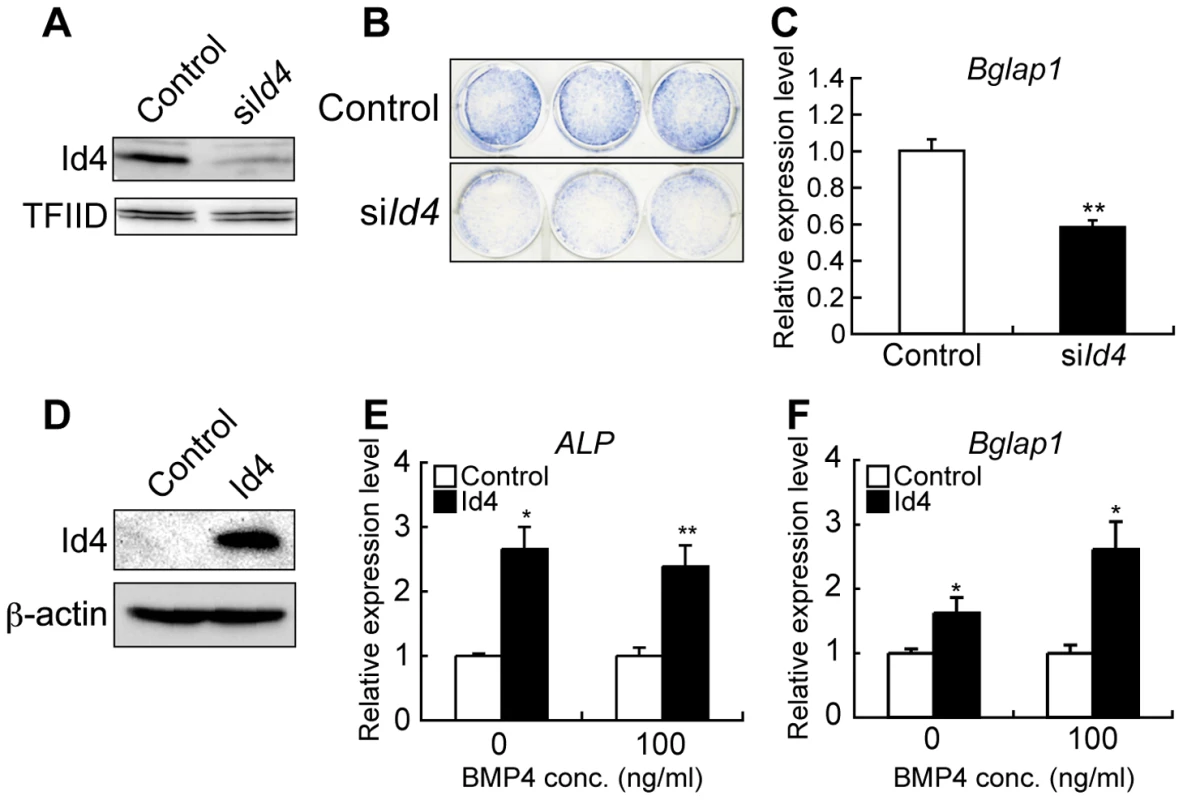
Id4 knockdown stimulates adipocyte differentiation, and overexpression attenuates lipid accumulation
Id4 knockdown in adipogenesis-induced ST2 cells (Figure 4A) significantly increased expression levels of other adipogenic marker genes such as Pparγ2 [15] and Adipoq [16] (Figure 4B and 4C). Concomitantly, the number of Oil Red O stained lipid droplets and triglyceride levels also increased (Figure 4D and 4E). Forced expression of Id4 was confirmed by transfection into Cos7 cells with Id4 expression vector (Figure 4F). Adipocytes differentiated from ST2 cells transfected with Id4 expression vector showed slightly but significantly decreased lipid accumulation compared to empty vector transfectants (Figure 4G). The combined results of Id4 siRNA knockdown and overexpression in ST2 suggest that Id4 attenuates differentiation of MSCs into adipocytes.
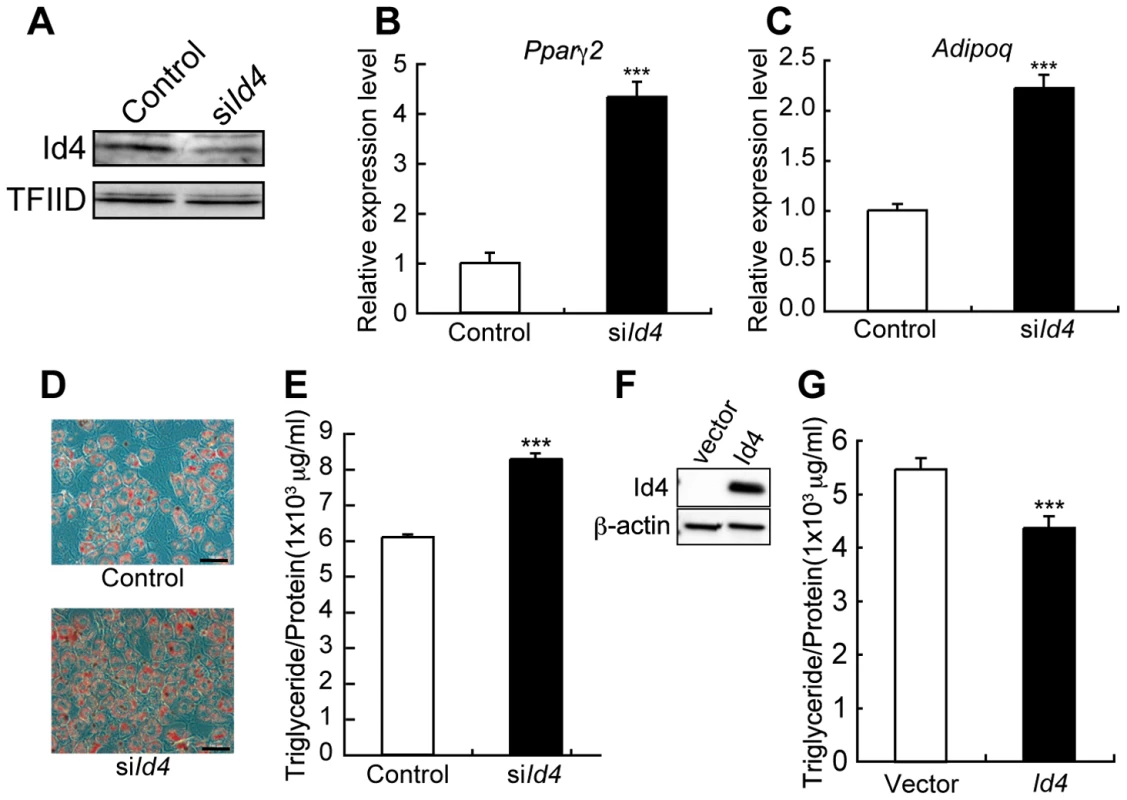
Id4-knockout mice (Id4−/−) showed impaired osteoblast differentiation
Previously Id4−/− mice were studied only in context of neural development [17]. We confirmed that Id4 expression was highest in the brain followed by cortical bone, kidney, thymus and bone marrow of C57BL/6J mice (Figure 5A). The body length and weight of 4 weeks old Id4−/− mice was 13–15% shorter and 35–40% lower compared to wild-type (Id4+/+) littermates (Figure 5B and 5C). Id4−/− mice showed severe growth retardation and died by 5 weeks. In addition, we observed visible skeletal phenotypes of Id4−/− mice, but no skeletal deformities (data not shown). Altogether, our data hint at an important role of Id4 in bone formation.
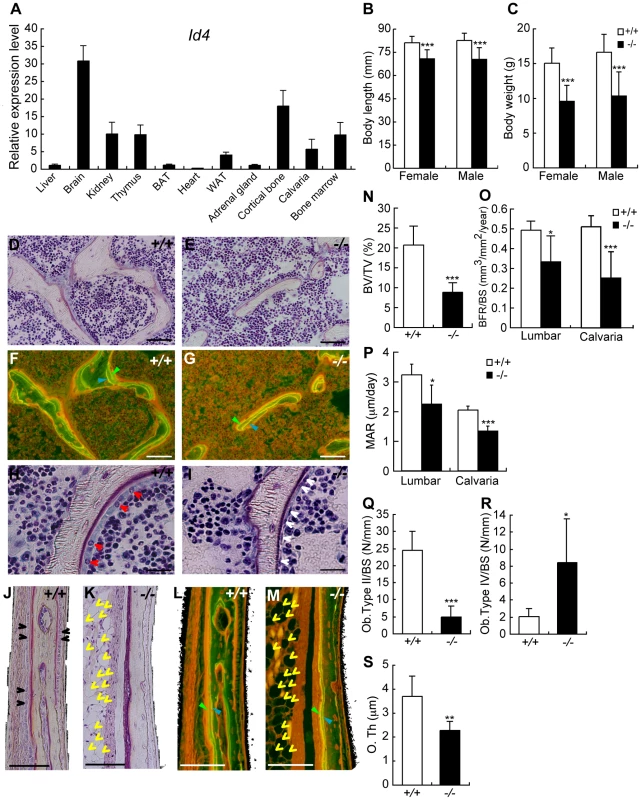
Bone histological analysis of Id4−/− mice revealed significantly decreased bone volume (BV) in the 6th lumbar (Figure 5D and 5E). The bone formation rate (BFR) was decreased in Id4−/− mice compared to Id4+/+ mice (Figure 5F and 5G). The BV to total volume ratio, BFR to bone surface (BS) ratio and mineral apposition rate (MAR) of Id4−/− mice were 57.3%, 28.1% and 30.7% lower compared to Id4+/+ mice in the 6th lumbar, respectively (Figure 5N–5P).
In Id4+/+ mice, active cuboidal-shaped osteoblasts (type II osteoblasts) were distributed in a row along the lumbar BS (Figure 5H), whereas in the corresponding region of Id4−/− mice osteoblasts were predominantly flat and resting (type IV osteoblasts; lining cells) (Figure 5I). The number of osteoblasts as a whole did not change significantly between Id4+/+ and Id4−/− mice (data not shown). However, in Id4−/− mice the population of active osteoblasts was reduced (type II, Figure 5Q), whereas inactive osteoblasts accumulated (type IV, Figure 5R). These findings imply that Id4 modulates both differentiation of osteoblasts from pre-osteoblasts and regulation of osteoblast maturation.
Impaired bone formation was also observed in the lateral calvaria of Id4−/− mice (Figure 5K and 5M). In wild type mice, osteoblasts were closely lined up along the calvarial BS (Figure 5J). In contrast, no osteoblasts were observed along the calvarial bone of Id4−/− mice (Figure 5K). The osteoid thickness, BFR to BS ratios and MAR of Id4−/− mice calvarial bones were 61.5%, 49.1% and 65.2% of Id4+/+ mice, respectively (Figure 5S, 5O, and 5P). These results suggest that Id4 is important for both endochondorial and membranous ossification. Growth Plate Width and Longitudinal Growth Rate (Lo. G. R) of Id4−/− mice tibia were 68.4% and 57.1% of Id4+/+ mice, respectively (Figure S3A, S3B, S3C, S3D), which may have caused the growth retardation of Id4−/− mice.
Id4 interacts with Hey2 and inhibits the transcriptional repression of Hey2
Id family members are known to heterodimerize with other bHLH transcriptional factors, thus inhibiting the binding to the E-box motif [18]. To explore whether heterodimerized Id4 switches the direction of osteoblast and adipocyte differentiation, we assayed Id4 protein-protein interactions and analyzed their effects. Using immunoprecipitation we attempted to capture for candidate bHLH transcription factors that bind to Id4. Out of four tested bHLH transcription factors (Hes1, hairy/enhancer-of-split related with YRPW motif 1; Hey1, hairy/enhancer-of-split related with YRPW motif 2; Hey2 and Bhlhe40) (Figure S4A), only Hey2 bound to Id4 (Figure 6A, Figure S4A and S4B). An earlier study demonstrated that Hey2 is forming heterodimers with Hes1, which then bind to the E-box motif and repress transcription [19]. Therefore, we tested the effect of Id4 on transcriptional repression of Hey2/Hes1 heterodimers against the E-box element. Transcriptional repression onto E-box element in the presence of either Hey2 or Hes1 showed no effect or 39% inhibition of E-box transcriptional activity relative to control (empty expression vector), respectively (Figure 6B). Although luciferase activity was lowest in the presence of both Hey2 and Hes1, inhibition of transcriptional repression by Id4 increased in dose-dependent manner (Figure 6B). We also demonstrated that Hey2-Hes1 binding was abrogated with the dose-dependent increase of Id4 (Figure 6C, lane 5 and lane 6). Taken together, we confirmed that Id4 reverses the transcriptional repression by Hey2-Hes1 heterodimer in a dose-dependent manner.
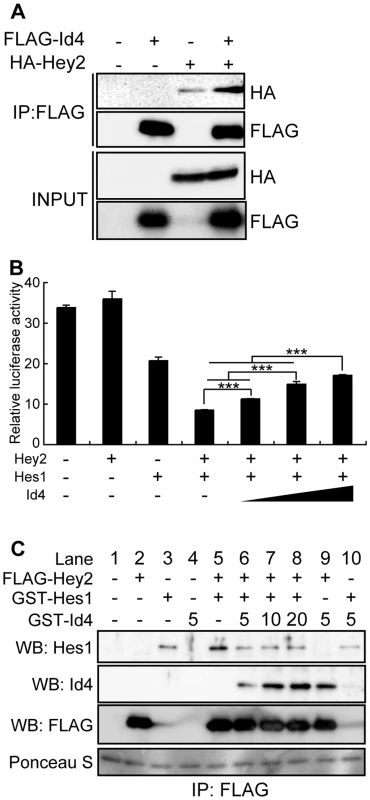
Id4/Hey2 complex indirectly enhances Runx2 transcriptional activity
The presence of inactive osteoblasts (Figure 5I and 5R) in the bone tissues of the Id4−/− mice let us assume that Id4 may affect the actions of Runx2 and Sp7, a key osteogenic differentiation molecule [20]–[22]. Osteoblast marker gene Bglap1 expression level decreased not only in primary osteoblasts but also in embryonic day18.5 (E18.5) limb of Id4−/− mice (Figure S5A and S5B). Bglap1, a target gene of Runx2 has an E-box element other than osteoblast-specific element 2 (OSE2), which binds Runx2 to the promoter [23]. Therefore, we measured the promoter activity to examine the influence of Id4 on Bglap1 E-box promoter-dependent transcriptional activity of Runx2. Although the suppression of Bglap1 promoter activity by addition of Hes1 and Hey2 was not detected, a dose-dependent increase of transcriptional activity by Id4 was observed when testing the OSE2 element-containing promoter. When using the promoter without OSE2 the increase in transcriptional activity was not seen (Figure 7A). Since direct interaction between Id4 and Runx2 was ruled out experimentally (data not shown), Id4 may indirectly influence Runx2 transcriptional activity through Hes1. Hes1 is known to stimulate the transcriptional activity of Runx2 protein by increasing its stability during osteoblast differentiation [24]. We also confirmed that the addition of Hes1 stabilizes Runx2 protein. Interestingly, the addition of Id4 further increased the stabilization and accumulation of Runx2 (Figure 7B). Taken together, it appears that Id4 enhances Runx2 transcriptional activity through stabilization of Runx2 protein.
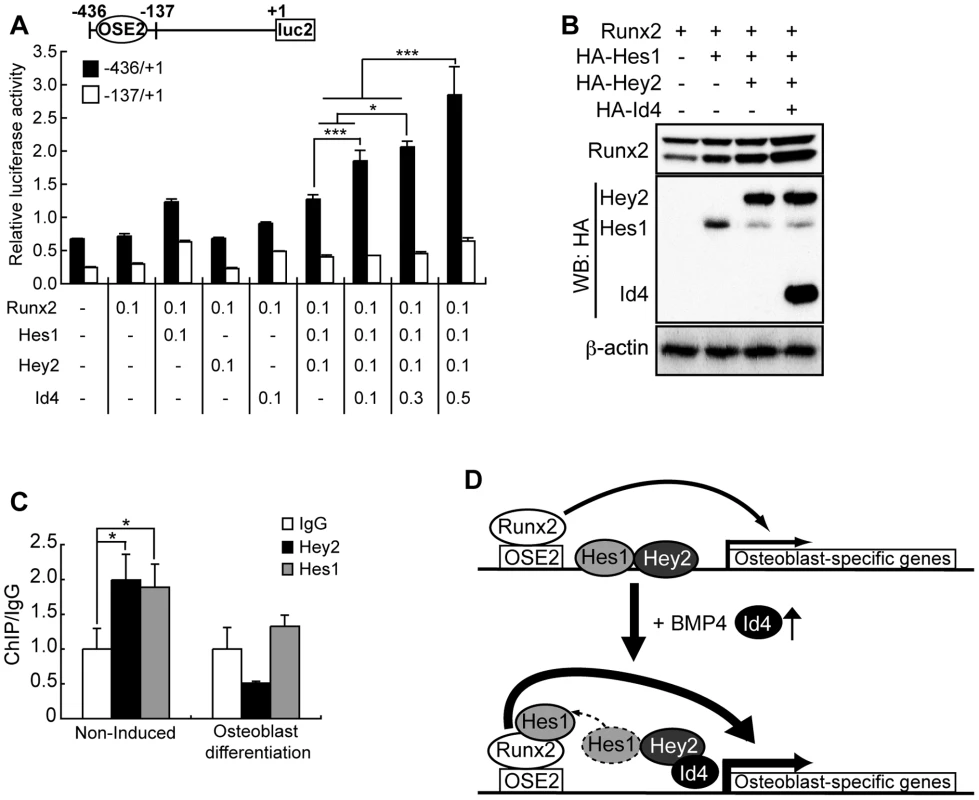
Taking into account the timing of the elevated Id4 expression (Figure 2C and Figure S2A), our results strongly suggest that Id4 is indirectly driving the Hes1-mediated Runx2 stabilization during osteoblast differentiation. The facts that both Hes1 and Hey2 bind to the OSE2 element-containing Bglap1 promoter region assessed by ChIP-qPCR, and that the amount of bound Hes1 and Hey2 decreased in ST2 osteoblasts (Figure 7C) further support this idea. However, the exact binding site of Hes1-Hey2 heterodimer remains to be identified. The proposed mechanism of Id4 action during osteoblast differentiation is illustrated in Figure 7D.
Id4−/− mice showed increased adipocytes
Id4 knockdown promoted adipocyte differentiation in ST2 cells (Figure 4B–4E). Histological analysis of Id4−/− tibia bones revealed elevated numbers of adipocytes in epiphyseal bone marrow of tibia compared to Id4+/+ mice (Figure 8A–8D). The entire analyzed area of epiphyseal tibia bone marrow was occupied by adipocytes in Id4−/− mice (Figure 8E). Moreover, Pparγ2 expression levels were also increased in bone marrow cells of femur and tibia of Id4−/− mice (Figure 8F). In comparison to Id4+/+ mice, the number of adipocytes in the lateral calvaria was markedly increased in Id4−/− mice (Figure 5K). These aberrant traits observed in Id4−/− mice implicate Id4 as a crucial molecule in the lineage choice of MSCs differentiating into either osteoblasts or adipocytes (Figure 8G).
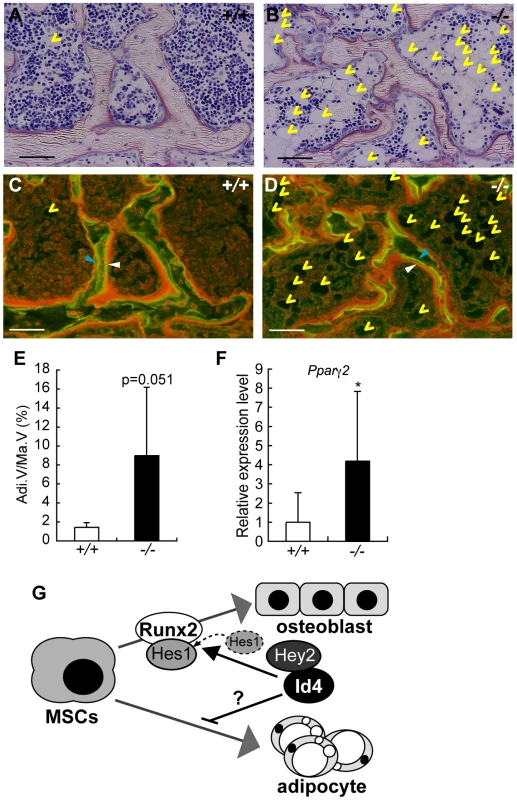
Discussion
In this study, we have delineated clusters of transcription factors that act as key regulators in the osteoblast and adipocyte differentiation network. The observation of sometimes disparately regulated transcription factors, led us to hypothesize a molecular switch function that promotes lineage-specific differentiation (e.g. osteoblast differentiation) and inhibits alternative differentiation pathways (e.g. adipocyte differentiation). To substantiate the hypothesis, we clustered gene expression profiles during osteoblast/adipocyte differentiation and identified Id4 as a candidate regulator of cell lineage choice. Id family members Id1–4 also belong to the bHLH superfamily, but lack the DNA binding domain. Heterodimerization of Id proteins with other bHLH proteins facilitates dominant negative regulation. A study by Bedford et al. using Id4−/− mice established Id4 as a regulator of proliferation and differentiation of neural precursor cells [17]. Until now, however, bone and skeletal abnormalities of this mouse model have not been reported. Besides our report, expression profile studies of BMP-independent osteoblast differentiation of human MSCs and BMP2-induced osteoblast differentiation using calvarial cells derived from Runx2-deficient mice [25], [26] demonstrated that the expression level of Id4 gene increases during osteoblast differentiation. These results suggest that Id4 plays an important role during osteoblast differentiation. Yet, the precise mechanism of Id4 action and regulation remained enigmatic. We have clearly demonstrated by in vitro and in vivo loss-of-function analysis that Id4 enhances osteogenic differentiation. Furthermore, we established a model of Id4 playing the role of molecular switch in osteoblast differentiation of MSCs (Figure 7D). Id4 expression increases upon BMP-induced osteoblast differentiation. Accumulating Id4 proteins transiently interact with Hes1-bound Hey2, thus triggering the release of Hes1 and the formation of Id4-Hey2 heterodimers and Hes1-Runx2 complexes. The binding of Hes1 to Runx2 potentiates the transcriptional activity of Runx2 and therefore osteoblast differentiation.
Hes1 and Hey2 are the target molecules of Notch signaling [19]. Until now, the relationship between Notch and BMP signaling pathways has been characterized by conflicting reports. On one hand experiments using ST2 cells showed that Notch1 suppresses the BMP-induced differentiation into osteoblasts [27]. On the other hand, Nobta et al. [28] reported that Notch signaling enhances BMP-induced osteoblast differentiation of C2C12 or MC3T3-E1 cells. At this point, there are insufficient data to resolve the controversy about the role of Notch signaling in BMP-induced osteoblast differentiation. However, our model (Figure 7D) may help to clarify the function of Notch signaling. In the absence of Id4, Hes1-Hey2 heterodimer just occupies the promoter region of the Runx2 target gene, whereas in the presence of Id4, Id4-Hey2 and Hes1-Runx2 complexes increase simultaneously. The concomitant increase of both complexes enhances the transcriptional activity of Runx2. Thus, we propose that availability and concentration of Id4 might account for the disparate roles of Notch signaling.
In Id4−/− mice, the drop of calvarial BFR is consistent with the phenotype of Id1/Id3 heterozygous knockout mice. After BMP stimulation, Id1/Id3 heterozygous knockout mice-derived calvarial cells showed reduced proliferation activity compared to calvarial cells derived from wild-type mice [29]. Thus, the decreased rate of calvarial bone formation in Id4−/− mice might be the consequence of reduced osteoblast proliferation. The expression levels of Id1and Id2 were also up-regulated in the early stage of BMP4-induced osteoblast differentiation (Figure 2A). Indeed, it has been reported that Id1 is an important early gene in osteoblasts after BMP stimulation [30], [31]. Although the biological significance of Id1 in the regulation of MSCs has to be elucidated in future studies, in ST2 cells, expression levels of Id1 and Id2 immediately returned to base levels (Figure 2C). In contrast, Id4 expression levels in ST2 and 3T3-E1 cells continued to rise until 4 days (Figure 2C and Figure S2A) and 7days, respectively [32].
Systemic hormones and local cytokines are known to be central regulators of bone formation. Serum levels of growth hormone (IGF1) and thyroid hormones (T3 and T4) did not change significantly between Id4+/+ and Id4−/− mice (data not shown). Hence, impaired bone formation is most likely independent of hormonal factors and caused by repression of osteoblast differentiation.
Since the expression level of Id4 decreases during adipocyte differentiation (Figure 2C and Figure S2B), Id4 was believed to inhibit MSCs differentiation into adipocytes. We demonstrated that Id4 suppression promoted adipocyte differentiation (Figure 4B–4E and Figure 8A–8E), but Id4 overexpression slightly decreased lipid accumulation level in ST2 adipocytes (Figure 4G). In an effort to shed light on the molecular mechanism, we assayed the expression level of Pparγ2, a master regulator of adipocyte differentiation. Pparγ2 expression increased in adipogenic-induced ST2 cells when Id4 was knocked down (Figure 4B) and in bone marrow cells of femur and tibia of Id4−/− mice (Figure 8F). However, the results of luciferase reporter assays ruled out effects of Id4 on the promoter activity of Pparγ2 (data not shown). Pparγ2 down-regulation by Id4 might involve a yet unknown, indirect regulatory mechanism. We noticed that the number of osteoclasts increased in the tibial epiphyseal regions and the 6th lumbar vertebra (data not shown). In view of an earlier report on Pparγ promoting osteoclast differentiation by activating c-fos [33], we interpret the increased number of adipocytes and osteoclasts in 6th lumbar and tibial bone of Id4−/− mice as a result of indirect activation of Pparγ1 and/or Pparγ2 transcriptional activity by lack of Id4. To corroborate these assumptions, additional analyses of the relationships and interactions of Id4, Pparγ and c-fos in context of adipocyte and osteoclast differentiation are necessary.
In summary, delineating clusters of transcription factors is a powerful strategy to identify cell fate-determining members of regulatory networks. Concerted application of our genome-wide expression profiling analyses and validation of transcription factor candidate regulators synthesize knowledge of specific molecular mechanism underlying osteoporosis and/or metabolic disease. In case of Id4, our findings reflect the potential pen-ultimate position of Id4 in the Runx2 activation/repression, which permits the differential integration of various upstream signals. Since BMP and Notch signaling affect osteoblast differentiation at different phases of differentiation, modulation of Id4 expression may create new venues for treating the onset of osteoporosis.
Materials and Methods
Cell culture
ST2 cells were obtained from RIKEN BioResource Center (BRC, Tsukuba, Japan) and cultured as described [34]. Primary osteoblasts were isolated from Id4+/+ and Id4−/− neonatal calvarial bone as described previously [35]. Osteogenic differentiation was induced by changing the medium every three days to culture medium supplemented with 100 ng/ml of bone morphogenetic protein 4 (BMP4) (R&D Systems, Mineapolis, MN) and adipogenic differentiation was induced by changing the medium to differentiation medium supplemented with 10% fetal bovine serum (FBS), 0.5 mM 3-isobutyl-1-methlxanthine, 0.25 µM dexamethasone, and insulin-transferrin-selenium-X supplement containing 5 µg/ml of insulin (Invitrogen, Carlsbad, CA) and 1 µM rosiglitazone. After 48 hr, the differentiation medium was replaced with culture medium supplemented with 10% FBS.
Id4 knockdown by siRNA
siRNA sequences targeting the mouse Id4 transcript were purchased from Ambion (for adipocyte) and Invitrogen (for osteoblast). AllStar Negative Control siRNA (QIAGEN, cat. No., 1027281) and Negative Universal Control Med#2 (Invitrogen, cat. No., 12935-112) was used as a negative control in adipocyte and osteoblast differentiation, respectively. The sequences of siRNA used for Id4 knockdown were as follows; sense, CCUUUGUAUUUGACGUGUAtt; antisense, UACACGUCAAAUACAAAGGtt (Ambion, cat No. AM16704, ID. 159536); for adipocyte differentiation; sense, UUAAUUUCUGCUCUGGCCCUCCCUU; antisense, AAGGGAGGGCCAGAGCAGAAAUUAA (Invitrogen, stealth_455, cat No. 10620312); for osteoblast differentiation. For siRNA transfection, a complex of Lipofectamine 2000 (Invitrogen) and 20 nM siRNA was prepared according to the manufacturer's instruction and directly mixed with cells in the culture plates. The medium was replaced at 4–6 hr after transfection with fresh differentiation medium (adipogenic induction) or 10% FBS supplemented with 100 ng/ml of BMP4 (osteogenic induction).
Lipid assay and Alkaline phosphatase (ALP) staining
Lipid accumulation in adipocytes was detected by using Oil Red O staining as described previously [36]. The triglyceride content in adipocytes was determined as follows. ST2 cells were washed with cold phosphate-buffered saline (PBS) and total lipids were extracted with chloroform/methanol (2∶1, v/v). The lower organic phase was dried, and the lipids were dissolved in 2-propanol. The triglyceride content was measured using Triglyceride E-test (Wako, Japan) according to the manufacturer's instructions. Protein concentrations were determined with Quick Start Bradford Dye Reagent (BIO RAD, 500-0205), using bovine gamma globulin as standard. ALP staining and measurements were performed as described previously [34].
Isolation of total RNA and quantitative real-time PCR (qRT–PCR)
Total RNA was isolated from liver, brain, kidney, thymus, brown adipose tissue (BAT), heart, white adipose tissue (WAT), adrenal gland, cortical bone, calvaria, bone marrow and posterior limb of E18.5 mouse embryo using TRIzol reagent (Invitrogen) and RNeasy columns (QIAGEN, Hilden, Germany) according to the manufacturer's instructions. Bone marrow was obtained by slicing of the ends of femur and tibia bones and then flushing it out with PBS using a syringe. Yield and quality of RNA were determined with a NanoDrop spectrometer (NanoDrop Technology, San Diego, CA) and a BioAnalyzer (Agilent Technologies, Santa Clara, CA). Gene expression levels were measured by qRT-PCR as described previously [34]. The sequences of forward and reverse primers used for each gene amplification were as follows; gapdh, GAPDH_768Fw_qPCR 5′-TGGAGAAACCTGCCAAGTATG-3′, GAPDH_889Rv_qPCR 5′-GGAGACAACCTGGTCCTCAG-3′; Id4, Mm_Id4_532Fw 5′-AGGGTGACAGCATTCTCTGC-3′, Mm_Id4_658Rv 5′-CCGGTGGCTTGTTTCTCTTA-3′; Pparγ2, PPARg2Fw 5′-ATGGGTGAAACTCTGGGAGA-3′, PPARg2-1Rv 5′-GAGCTGATTCCGAAGTTGGT-3′; Bglap1, OC(PM15547142)Fw 5′-CTCTGTCTCTC TGACCTCACAG-3′, OC(PM15547142)Rv 5′-GGAGCTGCTGTGACATCCATAC-3′; Adipoq, Mm_AdipoQ_298Fw 5′-GATGGCACTCCTGGAGAGAA-3′, Mm_AdipoQ_443Rv 5′-GCTTCTCCAGGCTCTCCTTT-3′.
Expression microarray experiments
RNA was extracted from differentiating ST2 osteoblasts and adipocytes after induction of differentiation, using PureLink miRNA Isolation Kit (Invitrogen) according to the manufacture's instructions for total RNA purification. Total RNA derived from ST2 at 0 hr was used as control. Biotin-labeled cRNA was synthesized as recommended by Affymetrix guidelines. Labeled samples were hybridized to the Affymetrix GeneChip Mouse Genome 420 2.0 arrays according to the manufacturer's protocol. Scanning and intensity data analysis was preformed as described elsewhere [37].
Expression profiling analyses in ST2 osteoblast and adipocyte differentiation
Collected microarray expression data was background-subtracted, and normalized using the robust multi-array analysis method [37]. Differentially expressed genes were determined by selecting expression subgroups that contained the probe sets of up/down-regulated genes. Genes were considered up-regulated (down-regulated) if their log2 intensity ratio was greater (less) than 1 (−1), or greater (less) than the mean plus (minus) 3-times standard deviation. All gene and probe set annotations were derived from Ensembl release 52. Genes with transcription-related Gene Ontology (GO) annotations (Table 3) were considered as transcription factor-coding genes. Genes with InterPro accession IPR001092 were annotated as bHLH transcription factor-coding genes. Spotfire DecisionSite version 8.1.1 (TIBCO Software, Inc.) was used for hierarchical clustering and generating the gene expression heat maps.
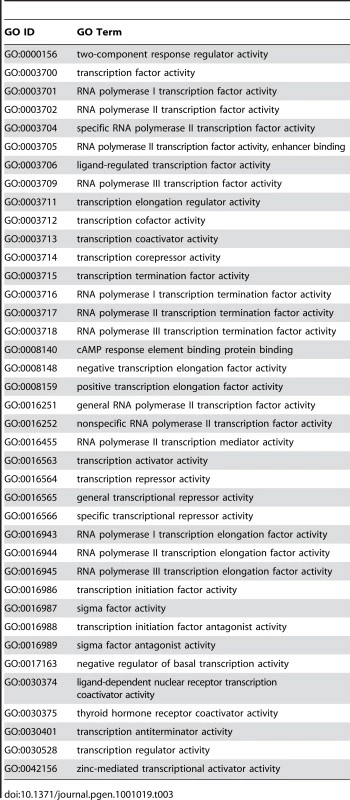
Luciferase reporter assays
Bglap1 promoter regions were cloned by PCR from the mouse genome. 6×E-box sequence (CGCGTCCACGTGGGGCCACGTGGGGCCACGTGGGGCCACGTGGG GCCACGTGGGGCCACGTGGGGA) and cloned fragments were ligated to the firefly luciferase gene (derived from pGL4.10, Promega). CV1 cells were co-transfected with the firefly luciferase reporter vectors, expression vectors and the internal control Renilla luciferase vector (pGL4.74, Promega) using Lipofectamine 2000 (Invitrogen). Luciferase activities were measured with Wallac 1420 Multilabel counter (PerkinElmer Life and Analytical Sciences, Turku, Finland). These experiments were performed in triplicate.
Co-immunoprecipitation and GST–pull down assay
Cos7 cells were transfected with FLAG-Id4 expression vector with either HA tagged expression vector (Hes1, Hey1, Hey2, Bhlhe40). The extracts from the transfected cells were incubated with Protein G sepharose beads and precipitated with either anti-FLAG antibody (SIGMA) or normal mouse IgG (Santa cruz) overnight at 4C°. After washing with PBS, bound proteins were separated by SDS-PAGE followed by Western blot analysis with anti-HA antibody, anti-FLAG antibody. GST-Id4 expression vector, Flag-Hey2 expression vector and Flag-empty vector were expressed in E.coli. The crude extract of GST-Id4 or GST expressed in E.coli was incubated with glutatihione sepharose beads for 4 hr at 4C°. The precipitate was incubated with the extract of Flag-Hey2 overnight at 4C°. After washing, the bound proteins were separated by SDS-PAGE followed by Western blot analysis with anti-Flag antibody.
Chromatin Immunoprecipitation (ChIP)–qPCR analysis
ChIP was performed as described previously [38]. ST2 cells were cultured for 4 days with or without 100 ng/ml BMP4, respectively. The antibodies used for ChIP were anti-Hey2 (Protein Tech Group, cat No. 10597-1-AP), anti-Hes1 (Santa Cruz, H-140) and normal rabbit IgG (Santa Cruz, sc-2027) as negative control. Forward and reverse qPCR primer sequences contained OSE2 of the Bglap1 promoter (Bglap2_ChIP_L789, 5′-GATTGTGGCCTCTCGTC-3′;Bglap2_ChIP_R8, 5′- ATCGGCTACTCTGTGCTCT-3′).
Animals
Id4−/− mice previously generated by Bedford et al. (2005) were kindly supplied by Dr. Kondo who received them originally from Dr. Sablitzky (University of Nottingham). All mice used in this study were maintained and handled according to the protocols approved by the Animal Research Committee of Saitama Medical University.
Bone morphometric measurements
To assess the static and dynamic parameters of bone histomorphometry, 3 weeks old female mice were labeled with intraperitoneal injections of 20 mg/kg of tetracycline hydrochloride (Sigma) at 4 days before sacrifice. Two days before sacrifice, the mice were injected with 10 mg/kg of calcein (Dojindo Co., Kumamoto, Japan). Tibiae and lumbar vertebrae were removed from each mouse, and fixated with 70% ethanol. The bones were trimmed to remove the muscle, stained with Villanueva bone stain for 5 days, dehydrated in graded concentrations of ethanol, and embedded in methyl-methacrylate (Wako Chemicals, Kanagawa, Japan) without decalcification. Sagittal plane sections (5 µm thick) of the lumbar vertebrae were cut using a Microtome (Leica, Germany). Bone morphometric analyses were performed using a semi-automatic image analyzing system software (System Supply, Nagano, Japan) and Optiphot fluorescent microscope (Nikon, Tokyo, Japan).
Supporting Information
Zdroje
1. BurkhardtR
KettnerG
BohmW
SchmidmeierM
SchlagR
1987 Changes in trabecular bone, hematopoiesis and bone marrow vessels in aplastic anemia, primary osteoporosis, and old age: a comparative histomorphometric study. Bone 8 157 164
2. NuttallME
GimbleJM
2004 Controlling the balance between osteoblastogenesis and adipogenesis and the consequent therapeutic implications. Curr Opin Pharmacol 4 290 294
3. AkuneT
OhbaS
KamekuraS
YamaguchiM
ChungUI
2004 PPARgamma insufficiency enhances osteogenesis through osteoblast formation from bone marrow progenitors. J Clin Invest 113 846 855
4. KobayashiH
GaoY
UetaC
YamaguchiA
KomoriT
2000 Multilineage differentiation of Cbfa1-deficient calvarial cells in vitro. Biochem Biophys Res Commun 273 630 636
5. LianJB
SteinGS
JavedA
van WijnenAJ
SteinJL
2006 Networks and hubs for the transcriptional control of osteoblastogenesis. Rev Endocr Metab Disord 7 1 16
6. NishimuraR
HataK
IkedaF
IchidaF
ShimoyamaA
2008 Signal transduction and transcriptional regulation during mesenchymal cell differentiation. J Bone Miner Metab 26 203 212
7. TakadaI
MiharaM
SuzawaM
OhtakeF
KobayashiS
2007 A histone lysine methyltransferase activated by non-canonical Wnt signalling suppresses PPAR-gamma transactivation. Nat Cell Biol 9 1273 1285
8. IwataT
KawamotoT
SasabeE
MiyazakiK
FujimotoK
2006 Effects of overexpression of basic helix-loop-helix transcription factor Dec1 on osteogenic and adipogenic differentiation of mesenchymal stem cells. Eur J Cell Biol 85 423 431
9. BuskinJN
HauschkaSD
1989 Identification of a myocyte nuclear factor that binds to the muscle-specific enhancer of the mouse muscle creatine kinase gene. Mol Cell Biol 9 2627 2640
10. ArnoldHH
BraunT
1996 Targeted inactivation of myogenic factor genes reveals their role during mouse myogenesis: a review. Int J Dev Biol 40 345 353
11. KimJB
SpiegelmanBM
1996 ADD1/SREBP1 promotes adipocyte differentiation and gene expression linked to fatty acid metabolism. Genes Dev 10 1096 1107
12. RossSE
GreenbergME
StilesCD
2003 Basic helix-loop-helix factors in cortical development. Neuron 39 13 25
13. RossDA
HannenhalliS
TobiasJW
CoochN
ShiekhattarR
2006 Functional analysis of Hes-1 in preadipocytes. Mol Endocrinol 20 698 705
14. LeeJS
ThomasDM
GutierrezG
CartySA
YanagawaS
2006 HES1 cooperates with pRb to activate RUNX2-dependent transcription. J Bone Miner Res 21 921 933
15. TontonozP
HuE
GravesRA
BudavariAI
SpiegelmanBM
1994 mPPAR gamma 2: tissue-specific regulator of an adipocyte enhancer. Genes Dev 8 1224 1234
16. HuE
LiangP
SpiegelmanBM
1996 AdipoQ is a novel adipose-specific gene dysregulated in obesity. J Biol Chem 271 10697 10703
17. BedfordL
WalkerR
KondoT
van CruchtenI
KingER
2005 Id4 is required for the correct timing of neural differentiation. Dev Biol 280 386 395
18. SunXH
CopelandNG
JenkinsNA
BaltimoreD
1991 Id proteins Id1 and Id2 selectively inhibit DNA binding by one class of helix-loop-helix proteins. Mol Cell Biol 11 5603 5611
19. IsoT
SartorelliV
PoizatC
IezziS
WuHY
2001 HERP, a novel heterodimer partner of HES/E(spl) in Notch signaling. Mol Cell Biol 21 6080 6089
20. KomoriT
YagiH
NomuraS
YamaguchiA
SasakiK
1997 Targeted disruption of Cbfa1 results in a complete lack of bone formation owing to maturational arrest of osteoblasts. Cell 89 755 764
21. OttoF
ThornellAP
CromptonT
DenzelA
GilmourKC
1997 Cbfa1, a candidate gene for cleidocranial dysplasia syndrome, is essential for osteoblast differentiation and bone development. Cell 89 765 771
22. NakashimaK
ZhouX
KunkelG
ZhangZ
DengJM
2002 The novel zinc finger-containing transcription factor osterix is required for osteoblast differentiation and bone formation. Cell 108 17 29
23. DucyP
KarsentyG
1995 Two distinct osteoblast-specific cis-acting elements control expression of a mouse osteocalcin gene. Mol Cell Biol 15 1858 1869
24. SuhJH
LeeHW
LeeJW
KimJB
2008 Hes1 stimulates transcriptional activity of Runx2 by increasing protein stabilization during osteoblast differentiation. Biochem Biophys Res Commun 367 97 102
25. KultererB
FriedlG
JandrositzA
Sanchez-CaboF
ProkeschA
2007 Gene expression profiling of human mesenchymal stem cells derived from bone marrow during expansion and osteoblast differentiation. BMC Genomics 8 70
26. LiuT
GaoY
SakamotoK
MinamizatoT
FurukawaK
2007 BMP-2 promotes differentiation of osteoblasts and chondroblasts in Runx2-deficient cell lines. J Cell Physiol 211 728 735
27. SciaudoneM
GazzerroE
PriestL
DelanyAM
CanalisE
2003 Notch 1 impairs osteoblastic cell differentiation. Endocrinology 144 5631 5639
28. NobtaM
TsukazakiT
ShibataY
XinC
MoriishiT
2005 Critical regulation of bone morphogenetic protein-induced osteoblastic differentiation by Delta1/Jagged1-activated Notch1 signaling. J Biol Chem 280 15842 15848
29. MaedaY
TsujiK
NifujiA
NodaM
2004 Inhibitory helix-loop-helix transcription factors Id1/Id3 promote bone formation in vivo. J Cell Biochem 93 337 344
30. KatagiriT
ImadaM
YanaiT
SudaT
TakahashiN
2002 Identification of a BMP-responsive element in Id1, the gene for inhibition of myogenesis. Genes Cells 7 949 960
31. Lopez-RoviraT
ChalauxE
MassagueJ
RosaJL
VenturaF
2002 Direct binding of Smad1 and Smad4 to two distinct motifs mediates bone morphogenetic protein-specific transcriptional activation of Id1 gene. J Biol Chem 277 3176 3185
32. ZhangY
HassanMQ
LiZY
SteinJL
LianJB
2008 Intricate gene regulatory networks of helix-loop-helix (HLH) proteins support regulation of bone-tissue related genes during osteoblast differentiation. J Cell Biochem 105 487 496
33. WanY
ChongLW
EvansRM
2007 PPAR-gamma regulates osteoclastogenesis in mice. Nat Med 13 1496 1503
34. MizunoY
YagiK
TokuzawaY
Kanesaki-YatsukaY
SudaT
2008 miR-125b inhibits osteoblastic differentiation by down-regulation of cell proliferation. Biochem Biophys Res Commun 368 267 272
35. YangS
TakahashiN
YamashitaT
SatoN
TakahashiM
2005 Muramyl dipeptide enhances osteoclast formation induced by lipopolysaccharide, IL-1 alpha, and TNF-alpha through nucleotide-binding oligomerization domain 2-mediated signaling in osteoblasts. J Immunol 175 1956 1964
36. YagiK
KondoD
OkazakiY
KanoK
2004 A novel preadipocyte cell line established from mouse adult mature adipocytes. Biochem Biophys Res Commun 321 967 974
37. IrizarryRA
BolstadBM
CollinF
CopeLM
HobbsB
2003 Summaries of Affymetrix GeneChip probe level data. Nucleic Acids Res 31 e15
38. WakabayashiK
OkamuraM
TsutsumiS
NishikawaNS
TanakaT
2009 The peroxisome proliferator-activated receptor gamma/retinoid X receptor alpha heterodimer targets the histone modification enzyme PR-Set7/Setd8 gene and regulates adipogenesis through a positive feedback loop. Mol Cell Biol 29 3544 3555
Štítky
Genetika Reprodukční medicínaČlánek vyšel v časopise
PLOS Genetics
2010 Číslo 7
- Primární hyperoxalurie – aktuální možnosti diagnostiky a léčby
- Mateřský haplotyp KIR ovlivňuje porodnost živých dětí po transferu dvou embryí v rámci fertilizace in vitro u pacientek s opakujícími se samovolnými potraty nebo poruchami implantace
- Intrauterinní inseminace a její úspěšnost
- Akutní intermitentní porfyrie
- Srdeční frekvence embrya může být faktorem užitečným v předpovídání výsledku IVF
Nejčtenější v tomto čísle
- Extensive DNA End Processing by Exo1 and Sgs1 Inhibits Break-Induced Replication
- Question and Answer: An Anniversary Interview with Jane Gitschier
- Multi-Variant Pathway Association Analysis Reveals the Importance of Genetic Determinants of Estrogen Metabolism in Breast and Endometrial Cancer Susceptibility
- Lysosomal Dysfunction Promotes Cleavage and Neurotoxicity of Tau
